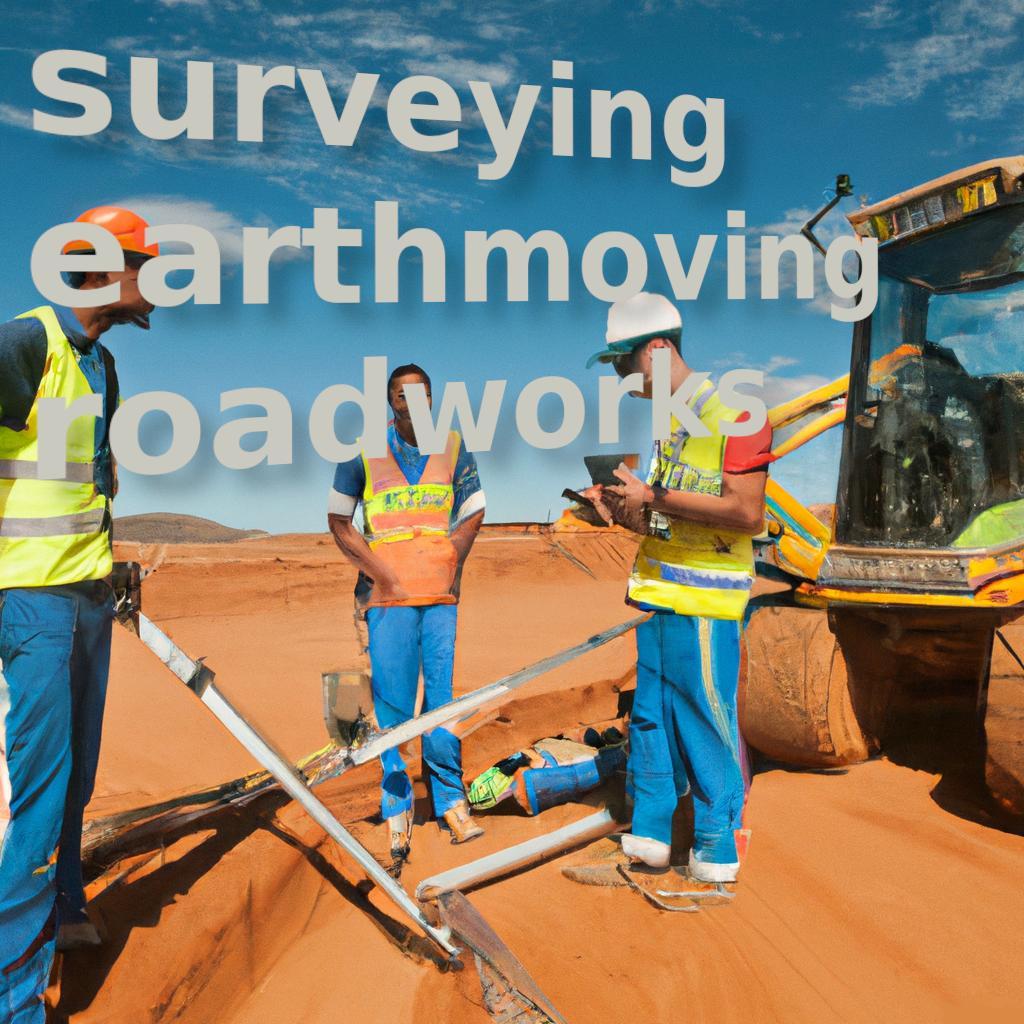


Asphalt arteries winding through urban landscapes, roadworks are the pulsing veins of progress, and at the heart of this intricate dance are the unsung heroes—the surveyors. In a world where infrastructure is the lifeblood of connectivity, roadworks and surveyors join forces to shape the thoroughfares that propel societies forward. Let's explore the fascinating realm where precision meets progress, and the meticulous art of surveying paves the way for smoother journeys.
The Canvas of Progress: Roadworks as Urban Tapestry
Roadworks, often synonymous with traffic cones and detour signs, are the brushstrokes on the canvas of urban progress. Whether it's the expansion of highways, the resurfacing of city streets, or the construction of intricate interchanges, roadworks are the tangible signs of a city in motion. While they may cause temporary inconveniences, their end goal is to enhance connectivity, improve safety, and elevate the overall infrastructure of a region.
Precision Pioneers: Surveyors Mapping the Path Ahead
At the forefront of roadworks are the unsung heroes armed with theodolites and GPS devices—surveyors. These meticulous professionals embark on a journey of precision, mapping the terrain, measuring elevations, and laying the groundwork for the roads of tomorrow. Their role extends beyond measuring distances; surveyors are the architects of spatial understanding, ensuring that every inch of the landscape is accounted for in the grand design of infrastructure development.
Unraveling the Landscape: The Art and Science of Surveying
Surveying is a delicate dance of art and science, where surveyors unravel the secrets hidden in the terrain. They employ theodolites to measure angles, total stations for precise distance calculations, and GPS technology for global positioning. The result is a detailed map that not only guides road construction but also factors in environmental considerations, drainage solutions, and topographical nuances.
From Blueprint to Reality: Surveyors as Infrastructure Architects
Surveyors play a pivotal role in translating architectural blueprints into tangible structures. They lay the groundwork for road construction by providing accurate data on land elevations, property boundaries, and potential obstacles. This information is crucial for engineers and construction crews, ensuring that the roadworks align with the planned design and adhere to safety standards.
Traffic Flow Symphony: Designing for Efficiency and Safety
The intricate ballet of roadworks includes considerations for optimizing traffic flow. Surveyors analyze existing traffic patterns, study intersections, and design road layouts that minimize congestion and enhance safety. Their work is akin to composing a symphony, orchestrating the movement of vehicles with precision to create a harmonious and efficient transportation network.
Navigating Challenges: Surveyors as Problem Solvers
Roadworks often encounter unexpected challenges, from rocky terrains to underground utilities. Surveyors, armed with problem-solving prowess, adapt to these challenges. They use ground-penetrating radar to detect subsurface structures, assess soil composition, and devise solutions that ensure the stability and longevity of the constructed roads.
Technological Evolution: Surveying in the Digital Age
Surveying has evolved in step with technological advancements. Modern surveyors leverage cutting-edge tools such as LiDAR (Light Detection and Ranging) and drone technology to enhance the speed and accuracy of their work. These innovations not only expedite the surveying process but also provide richer datasets for more informed decision-making in road construction projects.
Sustainable Infrastructure: Surveyors as Environmental Stewards
In an era where environmental sustainability is paramount, surveyors play a vital role in designing roads that minimize ecological impact. They assess the environmental footprint, consider stormwater management, and incorporate green infrastructure elements. By blending their scientific precision with a commitment to sustainability, surveyors contribute to the creation of roads that coexist harmoniously with the natural environment.
Earthmoving and roadworks are two related but distinct fields of construction.
Earthmoving involves the excavation, moving, and shaping of large quantities of soil and other materials. This work is typically done using heavy machineries such as bulldozers, excavators, and loaders. Earthmoving can be used for a variety of purposes, such as preparing building sites, creating roads and railways, and landscaping.
Roadworks, on the other hand, specifically involve the construction and maintenance of roads and highways. This work can include grading and shaping the road surface, laying asphalt or concrete, constructing drainage systems, and installing signs and barriers. Roadworks also involve the use of heavy machineries, such as asphalt pavers, rollers, and graders.
While earthmoving and roadworks are different fields, they are often closely related. For example, earthmoving may be required to prepare a site for road construction, and roadworks may involve earthmoving to grade and level the road surface. Both fields require specialized knowledge and expertise in construction, engineering, and heavy machinery operation.
A surveyor is a professional who specializes in measuring and mapping the physical features of the land, including its boundaries, contours, and elevation. Surveyors use a variety of tools and techniques, such as GPS, total stations, and drones, to accurately measure and record these features.
Surveyors play an important role in many different fields, including construction, land development, real estate, and government. They are often involved in the planning and design of new infrastructure projects, such as highways, bridges, and buildings, and they help ensure that these projects are built according to regulations and standards.
Surveyors may also be involved in mapping and surveying existing land features, such as property lines, topography, and natural resources. This information is used to create maps and plans that can be used for a variety of purposes, including land use planning, environmental management, and resource development.
In order to become a surveyor, one typically needs to earn a degree in surveying or a related field, and obtain a license or certification from a professional organization. Surveyors must have strong technical skills, as well as excellent communication and problem-solving abilities. They also need to be detail-oriented and able to work independently or as part of a team.
Before starting earthmoving, roadworks, or surveying projects, it's important to have a clear understanding of the scope of the project and the resources required to complete it. Here are some key things to consider:
Project goals and objectives: Understand the purpose and goals of the project. What needs to be accomplished? What is the timeline for completion? What are the budget constraints?
Site analysis: Conduct a thorough analysis of the site where the work will take place. This includes reviewing any existing plans or maps, examining the topography and soil conditions, identifying any environmental or legal constraints, and assessing the accessibility of the site.
Equipment and resources: Determine what equipment and resources will be required to complete the project. This includes heavy machinery, materials, labor, and any specialized tools or equipment needed for surveying.
Permits and regulations: Be aware of any permits or regulations that may be required for the project. This may include environmental permits, building permits, and zoning regulations.
Safety considerations: Develop a safety plan for the project, including identifying potential hazards and risks, implementing safety procedures, and providing appropriate safety equipment and training for workers.
Communication and collaboration: Establish clear lines of communication and collaboration among all stakeholders involved in the project, including the construction team, surveyors, engineers, and any regulatory agencies.
By carefully considering these factors before starting earthmoving, roadworks, or surveying projects, you can help ensure that the project is completed safely, efficiently, and within budget.
Here are some recent earthmoving and surveying new technologies:
Automated Earthmoving: With the development of automated earthmoving equipment, such as autonomous bulldozers and excavators, operators can now control the machinery remotely, improving safety, efficiency, and accuracy.
3D Printing: 3D printing technology is being used to create scale models of buildings and landscapes, allowing designers and engineers to test and refine their designs before construction begins.
Drones: Drones equipped with surveying and mapping technology are being used to gather data and create 3D models of construction sites, allowing for more accurate planning and design.
Augmented Reality: With augmented reality technology, designers and engineers can superimpose digital models onto real-world environments, allowing them to visualize designs and make adjustments in real time.
Telematics: Telematics technology is being used to track and monitor equipment, allowing operators to optimize performance, reduce downtime, and improve safety.
Laser Scanning: Laser scanning technology is being used to create detailed 3D models of buildings and landscapes, allowing for more accurate measurements and assessments.
GPS and GIS: GPS and GIS technology is being used to create detailed maps and geospatial data, allowing for more accurate and efficient earthmoving and surveying.
Soil Sensors: Soil sensors are being used to measure soil moisture, temperature, and composition, allowing for more precise and efficient earthmoving and landscaping.
Virtual Reality: Virtual reality technology is being used to create immersive simulations of construction sites, allowing designers and engineers to visualize designs and identify potential issues before construction begins.
Cloud Computing: Cloud computing technology is being used to store and manage large amounts of data, such as surveying data and 3D models, making it easier to access and share information across multiple stakeholders.
Here are some examples of road works by new technology:
Self-Healing Concrete: Scientists are developing self-healing concrete that uses bacteria to repair cracks in the road surface, reducing the need for frequent repairs.
Solar Roadways: Solar roadways use solar panels embedded in the road surface to generate electricity, reducing the need for external power sources and contributing to renewable energy goals.
Smart Traffic Management Systems: Smart traffic management systems use sensors and data analytics to optimize traffic flow, reducing congestion and improving safety.
Electric Vehicle Charging Stations: With the rise of electric vehicles, more and more charging stations are being installed along roadways, allowing drivers to charge their vehicles on long trips.
Connected Cars: Connected cars are equipped with technology that allows them to communicate with other vehicles and with infrastructure, such as traffic lights and road signs, improving safety and reducing congestion.
Dynamic Lane Markings: Dynamic lane markings use LED lights embedded in the road surface to indicate lane changes and other information, improving safety and reducing confusion.
Smart Pavement: Smart pavement is equipped with sensors that can detect traffic, weather, and other conditions, allowing for more efficient road maintenance and management.
Augmented Reality Road Signs: Augmented reality technology can be used to create virtual road signs that appear in a driver's field of vision, providing real-time information and improving safety.
Self-Driving Cars: Self-driving cars are expected to become more common in the coming years, potentially reducing accidents and improving traffic flow.
3D Printing: 3D printing technology can be used to create road infrastructure components, such as barriers and curbs, reducing waste and improving efficiency.
The ballet of roadworks and the precision choreography of surveyors form the backbone of modern infrastructure. While roadworks shape the physical landscape, surveyors infuse it with intelligence and meticulous planning. Together, they navigate the complexities of urban development, ensuring that the roads we travel on are not just pathways but conduits of progress, connectivity, and a testament to the delicate dance between precision and progress.
Sincerely yours,

We use cookies
We use cookies and other tracking technologies to improve your browsing experience on our website, to show you personalized content and targeted ads, to analyze our website traffic, and to understand where our visitors are coming from. Privacy Policy.